This Section features scans I've made of assorted documents other than Pictures or Brochures, such as booklets or bulletins. Most are part of my Project HAM, i.e., scans of 40+ year-old vintage documents not authored by me but which were sent to me back then, and due to their perceived rarity (even uniqueness right now) I'm making them available here.
I scanned most paper documents at 300 dpi, resulting in hi-res 2,552 x 3,508 PNG images, which were then converted to multi-page PDF documents with embedded OCR'd texts (e.g.: to allow for copy/paste operations). Some of them also include text pages with my own Notes, providing background info and extra details.

(126 pages, scanned by Fernando del Rey, in Spanish with Notes in English)
This set of 27 programs for the HP-34C was developed by Eugenio E. Ubeda Forte in September, 1980. The truly excellent typewritten documentation for the programs is both very extensive (123 pages, average 4.5 pages per program) and comprehensive. The titles for all 5 categories and 27 programs follow, in both the original Spanish and in English: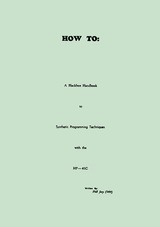
A 16-page booklet by Phill Jury (PPC #5484) which was sent to me by John McGechie (PPC Melbourne Chapter) circa 1980, and which I've discovered recently among my 40+ year-old vintage materials so I thought it would be proper to scan it and upload it to this Section as well. Phill says:
"This book is designed to teach the person who has neither the time nor the inclination to learn how the 41C goes about carrying out various non-standard techniques, but explains in detail (step by step instructions), how to use these techiques."

(10 pages, 8,946,653 bytes, scanned by Fernando del Rey)
The HP-35 is a 35-key, pocket-sized scientific and engineering calculator. [...] In terms of general advantages, this unit provides much of the problem-solving power of a desktop scientific calculator, combined with the portability and convenience of the slide rule. Unlike the slide rule, it offers unprecedented accuracy and provides answers in a fraction of the time required for slide rule calculation. This Capability Report will explain and evaluate special features of Hewlett-Packard's HP-35 Pocket Calculators, typical applications with comparison of solution times (*), how the unit operates, advanced technological features and general specifications.
(*) The following problems were selected from engineering notebooks and were given to members of Hewlett-Packard's own engineering staff for solutions. Each engineer was asked to time himself in working each problem in two ways: first, with a pilot model of the HP-35, and second, by conventional slide rule methods. Actual results are shown with comparison times, together with keystrokes for the HP-35 and scratch notes required for arriving at the slide rule solutions.
(28 pages, 37.699.863 bytes)
A Guide to Profitable Decision Making - Hewlett-Packard’s introduction to basic financial concepts every business manager should know. DECISIONS - the single most important factor facing a manager. This guide is about time and money.

(33 pages, 13.177.030 bytes, in Spanish and others)
This 32-page magazine arrived 1983-10-01 in a big envelope by regular mail sent from Barcelona (Spain). They sent me their #0 issue, which features an interesting mix of programs, routines, hint, tips, articles and even some adds, mostly for the HP-41C in this particular issue, including data sorting, artificial satellites' tracking, synthetics, polynomial arithmetic, "alien" games, special functions and numeric analysis, etc., in both Spanish and other languages. Includes HP-41C barcodes for the programs featured. Includes Notes.
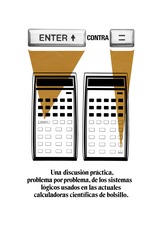
(8 pages, 6.663.984 bytes, in Spanish)
Calculadoras cientificas de bolsillo - la verdadera historia. Una discusion practica, problema por problema, de los sistemas logicos usados en las actuales (ca. 1977) calculadoras cientificas de bolsillo.
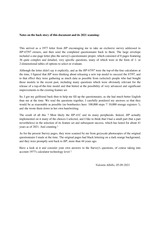
This arrived as a thick 1977 letter from HP "sent to only a few HP-67 and HP-97 owners", encouraging us to take a very comprehensive survey and then send the completed questionnaire back to them. The large envelope included a one-page letter plus the survey's questionnaire proper, which consisted of 8 pages featuring 36 quite complex and detailed, very specific questions. Oh, and a return envelope as well. Includes Notes.
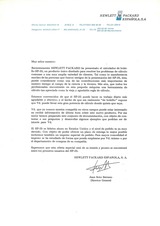
(5 pages, 4,269,189 bytes, in Spanish, scanned by Fernando del Rey)
Carta de HEWLETT-PACKARD ESPAÑOLA, S.A. dirigida a profesionales y empresas de ingenieria y arquitectura, presentando la nueva HP-35, adjuntando un folleto de 4 paginas a todo color que incluye una orden de pedido de una o mas unidades, ya sea a nivel corporativo o individual, y con pago mediante facturacion (40.000 Pts/unidad) o al contado (38.000 Pts/unidad), con posibilidad de devolución en el plazo de 10 dias.
(5 PDF, 52 pages)
Contains the following 5 Program Submittals to the HP Users' Program Library Europe: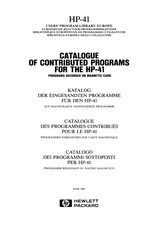
(100 pages, in English, Spanish, German, French, Italian, Other)
HP-41 Users' Program Library Europe - Catalogue of contributed programs for the HP-41.
This catalog contains user-contributed programs grouped by language (colour coded pages). To find a program of interest, first look up the Applications Category Table e.g. Astronomy 510. Then you go to the « Application Index » (e.g. under 510) and note the running number of all programs which appear relevant. Then you go to the « Program Abstracts » section where programs are listed in numerical order, together with a brief description.
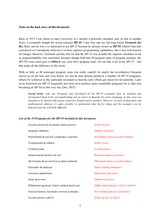
(31 pages, in Spanish, includes Notes in English)
Back in 1975 my friend Fernando del Rey owned an HP-55, an awesome calculator for the time but severely limited as far as programmability was concerned. With as little as 49 unmerged program steps you really couldn't do much but nevertheless Fernando strived to do his best and produced a number of HP-55 programs, which I've collected in this particular document so that his early efforts get preserved for posterity.

HP-65 Users' News Volume 1 Number 1. In this issue:
Inside an HP-65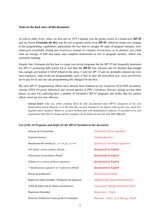
(51 pages, in Spanish and English, includes Notes in English)
Back in 1977 my friend Fernando del Rey owned an HP-67, a state-of-the-art calculator with the best programmability bar none. With 224 merged program steps and 26 addressable registers you could do wonders and both Fernando and I strived to do our best and produced a number of HP-67 quality programs. Many of mine I've already included in Cuaderno ICAI, and here I've collected in this particular document Fernando's early efforts (programs and drafts) so they won't get lost.
(16 PDF, 193 pages, scanned by Fernando del Rey)
Contains the following 16 Program Submittals to the HP Users' Program Library Europe:
00204 Pinball Wizzard
00205 Star Trek Advanced
00206 Dog Races
00210 Game of Life (9x9)
00222 Jack of Eagles (Game)
00252 LNAP (Ladder Network Analysis Program)
00297 LC-LNAP, LC Ladder Network Analysis Program
00301 Second Order Active Network Pole and Zero Polynomial Coefficients
00315 Curve Fitting Using the Cubic Spline Method
50003 Logic Circuit Simulator
50024 Sequential Logic for up to 9 Unknowns (Propositions)
50029 Car Simulator
50089 5th Degree Equation
50116 Coder - Decoder
50145 Magic Squares
50146 Solution of a Fifth or a Sixth Order Linear System
(16 PDF, 96 pages, scanned by Fernando del Rey)
Contains the following 16 Program Submittals to the HP Users' Program Library Europe:
50232 Direct PIAL Compiler
50256 Trade Business Plan Game
50313 PIAL Executer
50495 Multiple Integrals
50499 Reaction Time Indicator With NNN's
50500 Mate Your HP's King with King, Bishop and Knight, in 35 Moves
50520 Approximation by Legendre Polynomials up to Degree 7
50536 Lose Three
50555 PIAL Editor
50653 Nth Degree Polynomial .le.18 Bairstow Method
50657 Complex Operations Programmable 45
50683 Linear Systems (Complex Coefficients)
50684 Linear Systems 7x7
50685 Determinants
50687 Polynomial Regression Degree 1, 2, 3, 4
50696 Chess - End Game 1
(16 PDF, 101 pages, scanned by Fernando del Rey)
Contains the following 16 Program Submittals to the HP Users' Program Library Europe:
50784 Fourier Coefficients
50812 5x5, 4x4, 3x3 Matrices or Unknown Equations
50813 Conversion of Legendre Polynomials into Power Series
50925 Linear Second Order Boundary-Value Problem
51061 Inverse Mastermind
51114 Twonky
51130 Solving Mastermind with HP 67-97
51193 5x7 Matrix Letter and Symbol Printer
51262 Theseus and Minotaurus
51352 Chebyshev Economisation
51403 Double Precision Arithmetic for Positive Integers
51657 50 Steps Programmable HP Machine for Complex Calculus
51658 Approximation by a Sum of 4 Whatever Functions
51660 4 Simultaneous Equations in 4 Rational Variables
51702 Cyclic Patterns
51772 Texas Simulator
(16 PDF, 112 pages, scanned by Fernando del Rey)
Contains the following 16 Program Submittals to the HP Users' Program Library Europe:
51187 Game of Life (23x31)
51877 MIT Public-Key Cryptosystem and Digital Signatures
51881 Fourier Coefficients for Linear Composed Functions
51892 Literal Derivation Function up to 100 Steps
52046 Square Root to 182 Figures
52058 Sea Battle
52112 Palindromic Numbers
52165 Linear Systems
52206 A Chess Game
60084 BASIC 67
60377 Fourier Series - Harmonic Analysis - Discrete Domain
60453 Elliptic Lowpass Filter Design
60454 Factors of a Number_ the Fastest Program on the Subject
60534 Areas, Lengths of Arcs, Volumes & Surfaces of Revolution
60535 Numerical Analysis of Functions
60582 Summation of an Infinite Alternating Series

(84 pages, in English, Spanish, German, French, Italian, Other)
HP-67/97 Users' Program Library Europe - Catalogue of contributed programs for the HP-67/97.
This catalog contains user-contributed programs grouped by language (colour coded pages).

(28 pages, in English)
Supplement to the HP-67/97 Users' Program Library Europe - Catalogue of contributed programs for the HP-67/97
Features 520 new programs, with abstracts, including some contributed by Fernando del Rey (e.g.: 52055D - 67-Solution to a System of Linear Equations) and yours truly (e.g.: 52056D - 67-Incomplete Elliptic Integral of the 1st Kind & Functions.)
(16 PDF, 127 pages, 7,534,300 bytes, scanned by Fernando del Rey)
Contains the following 16 Program Submittals to the HP Users' Program Library USA:
00179D Space War
00200D Blackjack Game
00216D Mastermind Deluxe
00219D Shooting Gallery
00220D Game of Life
00256D Probe Word Game
00259D Duel
00266D Concentration
00278D Blackjack - Las Vegas Style
00321D Pinball Wizzard
00325 Cybernetic Nim Game
00326D Bagels1-5 Game
00369D Advanced Star Advanced
00463D Game of Life (9x9)
00499D Battleship I
00501D Baseball
(16 PDF, 109 pages, 6,689,422 bytes, scanned by Fernando del Rey)
Contains the following 16 Program Submittals to the HP Users' Program Library USA:
00537D Championship Golf
00538D Roulette Deluxe
00552D Fourty-Four_ A Game of Deduction
00555D Baseball
00586D Football
00616D Objective (Tank War)
00626D Life
00687D American Roulette Wheel
00727D Jack of Eagles
00733D Roulette Game
00734D Jotto 2
00739D Daytona 500
00747D Football
00825D Golf With Unique Putting Routine
00850D Number Hunt
00853D Orbitor Game
(16 PDF, 121 pages, 7,597,309 bytes, scanned by Fernando del Rey)
Contains the following 16 Program Submittals to the HP Users' Program Library USA:
00873D Basketball
00874D Ping-Pong
00875D Electronic Ping Pong
00888D Mastermind
00959D Programmers' Bell Slot Machine
00964D Robot Trap
01173D Hunt the Wumpus
01370D Blackjack
01412D Matrix Game - Calculator Learns to Learn
01471D Slalom Ski
01475D Rational Tic Tac Toe
01495D Baseball
01497D Crack the Vault
01511D Pinochle
01532D Moon Lander with Untinterruptible Continuous Countdown
01581D Sink the Yamamoto
(16 PDF, 117 pages, 7,948,985 bytes, scanned by Fernando del Rey)
Contains the following 16 Program Submittals to the HP Users' Program Library USA:
01650D Random Sequence of Numbers
01767D Magic Squares
01798D Bridg-It
01800D Fortress
01816D Monopoly
01829D Unbreakable Cipher System; Cryptography
01838D Draw Poker
01884D Noughts & Crosses
01918D Keno Simulation
01927D Advanced Battleship
02039D Super Bagels - Easy-Does-It
02335D Star Wars
02845D Space War Plus
02900D Telepathy
02913D Game of 15
02925D The Game of 3D Tic Tac Toe
(16 PDF, 87 pages, 5,491,953 bytes, scanned by Fernando del Rey)
Contains the following 16 Program Submittals to the HP Users' Program Library USA:
02962D Mine Field
03100D Bowling Game Simulator
03130D Keno Special
03288D Checkers
03952D How Old Are You
03954D Down the Middle
03958D I.Q. Tester
03961D Number Guesser Game
04061D Exterminator
04118D Toss and Score
04122D Fan Tan
04190D Sic Bo (Dice game)
04191D Paper Rock Scissors
04196D Labyrinth
04199D Guess the Number
04356D Engine Out
(4 PDF, 26 pages, 1,374,287 bytes, scanned by Fernando del Rey)
Contains the following 4 Program Submittals to the HP Users' Program Library USA:
04463D Catch Me If You Can
04464D Modified Moon Rocket Lander
04505D Chess - The 8 Queens Problem
04510D Guess the Card Suit

HP-28C. Use scientific calculator for symbolic mathematics.
The HP-28C Scientific Professional Calculator is a new technical calculator capable of doing symbolic mathematics. Algebra and calculus operations can be performed with a few keystrokes. Problems can be solved conceptually and numbers keyed in later.
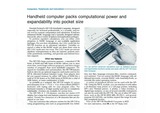
The HP-71B Handheld computer packs computational power and expandability into pocket size.
Hewlett-Packard's HP-71B Handheld Computer, designed especially for technical professionals, is a versatile, easy-to-use tool for numeric computation and calculation.
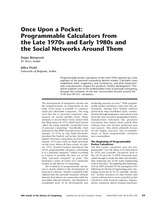
(12 pages, original document, not a scan)
Once Upon a Pocket: Programmable Calculators from the Late 1970s and Early 1980s and the Social Networks Around Them
Programmable pocket calculators of the mid-1970s opened up a new segment of the personal computing devices market. Calculator users established clubs, magazines, and conferences, and their interaction with manufacturers shaped the products’ further development. This article explores one of the understudied roots of personal computing, through the evolution of the user communities formed around the TI-59 and HP-41C calculators.
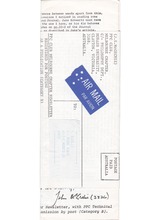
A complete 10-page newsletter published by the Australian PPC Club Melbourne Chapter, sent by John McGechie back in October 1980. If you zoom on the quite-faded thermal-paper label you'll see it's addressed to yours truly, and you'll also find me mentioned in page 3 of the newsletter (page 5 of the PDF), I quote:
"A long and fascinating letter from Valentin Albillo had arrived a few days before the meeting, reporting on his latest incredible work (see Overseas News), producing delighted cheers, especially when it was observed that he was one of the two or three overseas members of our Melbourne Chapter. (We are prepared to take all credit, of course...)"
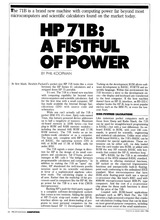
The HP-71B is a brand new machine with computing power far beyond most microcomputers and scientific calculators found on the market today.
At first blush, Hewlett-Packard’s pocket-size HP 71B looks like a cross between the HP Series 41 calculators and a stripped down HP 75 portable. It's not. The 71B is a brand new machine with computing capability far beyond most microcomputers and scientific calculators. And for the first time with a small computer, HP has made available the Internal Design Specifications (IDS) with source code and schematics. While one can't actually call the 71B a pocket IBM 370, it’s close.

Many users have wondered about the history behind the Series 40. It can be traced back to the introduction of the HP-41C on July 16, 1979. The HP-41C was promoted as the first alphanumeric, fully programmable, continuous memory, handheld calculator. The first HP-41 contained many first-time features such as liquid-crystal display and redefinable keyboard.
The HP-41C has 441 bytes of program memory or 63 data registers in the main memory configuration. The major peripherals available at introduction were the HP 82143 thermal printer and HP 82104 magnetic card reader. The HP 82153 optical wand for reading bar coded programs and data became available on July 1, 1980. [...]
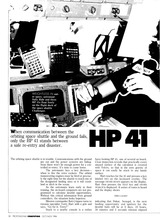
When communication between the orbiting space shuttle and the ground fails, only the HP 41 stands between a safe re-entry and disaster.
The orbiting space shuttle is in trouble. Communications with the ground are out and the power systems are failing. Soon there won’t be enough power for a controlled re-entry. It’s time to come home. [...] Stuck to a nearby console is a rather fuzzy-looking HP 41, one of several on board. [...]
Six months before the first shuttle flight, Terry Hart was asked to find the best calculator for the astronauts. He looked at the TI-59 and the HP 41, the most powerful units available, and decided that the 41’s alphanumeric display capability made it the clear winner.
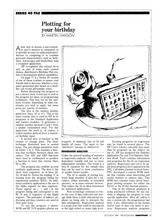
A sure way to arouse a non-computer user's interest in computers or to provide an easy-to-understand introduction to computing is to combine personal characteristics such as birthdays, horoscopes and biorhythms with a computer application. HP recognized this natural tie-in and, as part of some early system demos, distributed a Birthday Plot routine to demonstrate plotter capabilities. On page 77 is a Series 40 version of one of these routines to amaze your friends [...].
Before dismissing this program as just a showy trick, it may pay to look at the program for ideas on programming techniques. This may not be the optimum version, depending on what constraints you wish to apply, but some areas are worthy of mention. The first is the random number generator [...]
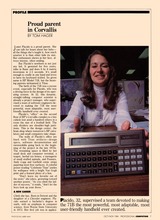
Janet Placido is a proud parent. [...] But Placido’s newborn is not just any kid. It gestated for five years, talks in BASIC and does 6 x 6 matrix inversions in 2.5 seconds. [...] Its given name is HP-71B, but the beaming parents nicknamed it Titan.
The birth of the 71B was a joyous event, especially for Placido, who was a driving force in the design of its operating system. At 32, this dynamic, straight-talking computer scientist is already a project manager, who supervised a team of software engineers devoted to making the 71B the most powerful, most adaptable, most user-friendly handheld ever created.
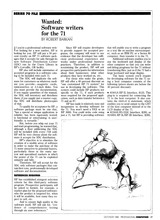
If you're a professional software writer looking for a new market, HP is looking for you. HP will pay a 50 percent royalty on HP 71 software packages that it accepts for sale through its new Software Distribution Center (SDC) run by the Users Library in HP’s Corvallis, OKR facility. HP also will include summaries of accepted programs in a software catalog to be included with each 71.
The SDC will duplicate the software for customers on whatever medium you provide—magnetic cards, minicassettes or 3.5-inch disks. You also must provide the documentation.
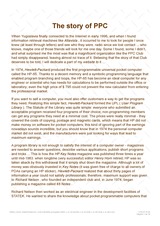
This is an automatic translation to English (pretty good quality, IMHO) of the original text written by Dejan Ristanovic, titled "Priča o PPC-ju", which can be found at www.dejanristanovic.com
The document features a short (10 pages) story of the PPC Club, from its original inception as 65 Notes in June 1974 to the demise of CHHU (PPC Club's follow-up) circa February 1987, as seen by Mr. Ristanovic. In his own words:
"[...] it occurred to me to look for people I once knew (at least through letters) [...] Some I found, some I didn’t, and what surprised me the most was that a magnificent organization like the PPC Club had simply disappeared, leaving almost no trace of it. Believing that the story of that Club deserves to be told, I will dedicate a part of my website to it ..."
.jpg)
This PDF document describes Project HAM (Historic Albillo Materials).
Since June 2021, I'm scanning most of my 40+ year-old still surviving vintage materials. My goal is to upload most everything I've kept stored since then, for interested people to download, read, and get an idea of that Golden Age.
My surviving vintage materials consist of some 4,000 pages, most of which I've scanned at 300 dpi, and have been kindly and expertly postprocessed by Eric Rechlin himself, then collected into multi-page PDF documents, which also include OCR'd text of variable quality. Additionally, some of them also contain a text file with my very own Notes detailing the document's background and interesting trivia.
The selected scanned vintage materials (which I'll upload on a regular basis) include, among others: [... read the full details in this PDF document ...]
COPYRIGHT NOTICE
These articles, programs, pictures, their descriptions and other materials created by me
are (c) Valentin Albillo, and can be used freely for non-profit purposes
as long as (1) the contents aren't modified in any way and (2) the copyright is acknowledged.
In plain words, you can download them and use them for non-profit purposes but do not include
them in any media and/or site for which you're asking money, do not tamper with their contents and
do not say or imply that you created them or that you don't know who created them, you must
always give due credit to me.